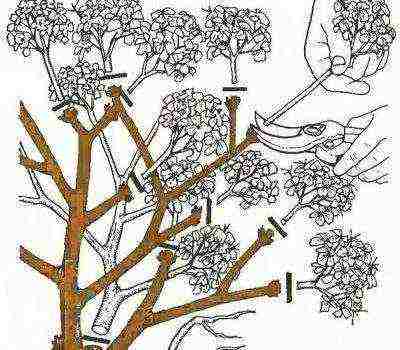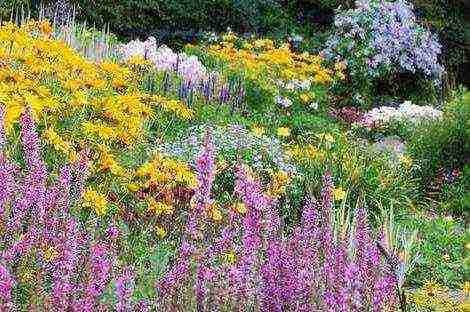Content
- 1 Site selection and soil preparation
- 2 Planting hydrangeas outdoors
- 3 Top dressing and mulching as the basis of care
- 4 Pruning hydrangeas - continue to groom
- 5 Garden hydrangea: photos, types, varieties
- 6 Features of growing garden hydrangea
- 7 Diseases and pests of garden hydrangea
- 8 Planting hydrangeas
- 9 Propagation of hydrangea
- 10 Hydrangea care
- 11 The main garden types of hydrangea

Hydrangea, planting and care are of no small importance when growing, since an unsuccessfully chosen place and soil composition of the soil can lead to diseases and poor development, in some cases death. In addition, after planting, you need to take care of the shrub correctly in order to achieve lush flowering and healthy growth ...
Site selection and soil preparation
When to plant a hydrangea? The best time for planting is spring, the moment when the earth thaws, the buds have not yet blossomed, and autumn is in the month of September. When choosing a place for an ornamental deciduous plant, keep in mind that it is better to plant a hydrangea in the shade or partial shade, since the bright sun causes slower growth, as a result of which the inflorescences become smaller.
Some types of hydrangeas can be grown in open, sunny areas, but this requires abundant watering. It is advisable to protect young shrubs from the bright sun and strong winds. It is not recommended to be placed under trees that strongly absorb water.
The soil for hydrangea should be well-drained and moistened, consisting of a balanced mixture of humus, leafy soil, peat chips, river sand (2: 2: 1: 1). Regardless of the type and variety of hydrangea, remember that lime in the soil has a negative effect on development. The soil should have a Ph level of about 5.0.
Planting hydrangeas outdoors
In the northern regions of the country, it is preferable to plant hydrangea in open ground in the spring, in the southern regions, including the Kuban, the procedure is carried out in the fall. It is recommended to equip a planting hole for a beautiful shrub, the dimensions of which are 0.4 m in diameter and a depth of 0.4-0.5 m.When planting, be guided by the size of the root system, if too large, increase the volume of the hole. It is worth noting that the roots of the hydrangea are quite branched.
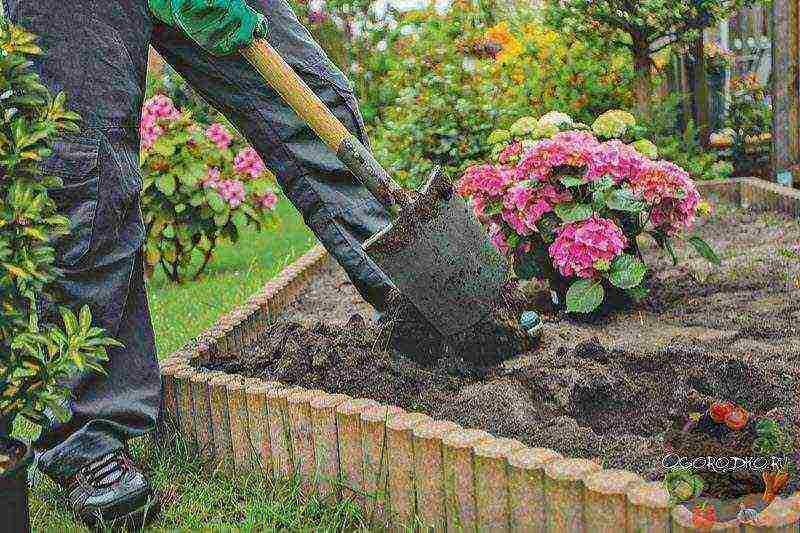
choosing a place and planting a hydrangea with a closed root system - in the photo
It is necessary to introduce the prepared soil mixture into the pit and make a small mound, on which the seedling is then carefully placed and the roots are straightened, they fall asleep without deepening the root collar, which should be flush with the soil. A slight deepening is permissible, but not more than 20-30 mm; too deep landing can subsequently lead to decay of the neck.
The soil in the near-trunk zone must be well tamped. Watering the hydrangea after planting is mandatory, it is necessary that the water seeps well to the depth of the roots of 30-40 cm. Watering is best done in the hole next to the plant.
Top dressing and mulching as the basis of care
To retain moisture after planting in a permanent place, the hydrangea is mulched in the trunk circle.Mulch also inhibits the growth of weeds and protects the roots from overheating. Peat chips, wood chips or bark are used as a mulching material, having a uniform layer of 8-10 cm.
Mulch will decompose over time and become part of the soil, slightly acidifying it. Mulch is best laid in late spring, when the ground is already well warmed up but still damp.
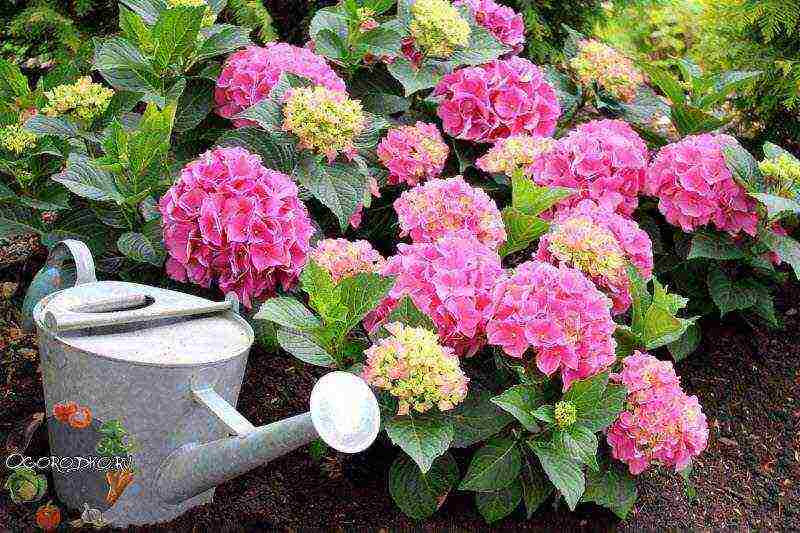 watering hydrangea - pictured
watering hydrangea - pictured
So that the shrub grows well and pleases with abundant flowering, the garden hydrangea is fertilized when planting, then in the spring in the third decade of May or in early summer - early June. Use a solution of mullein or chicken droppings diluted 1:10 with water. Do not forget to fertilize with a complex of mineral fertilizers or add at least the most basic components - 20 grams of superphosphate, 10 grams of potassium nitrate and urea each. Subsequent feeding of hydrangea is carried out with an interval of 17-20 days and ends at the end of July, so that the young shoots have time to woody by the winter period.
For strong and flexible shoots, an ornamental shrub is watered with a solution of potassium permanganate of a weak pink color. In addition, garden stores sell special fertilizers for hydrangeas, which include magnesium and iron, which the plant needs.
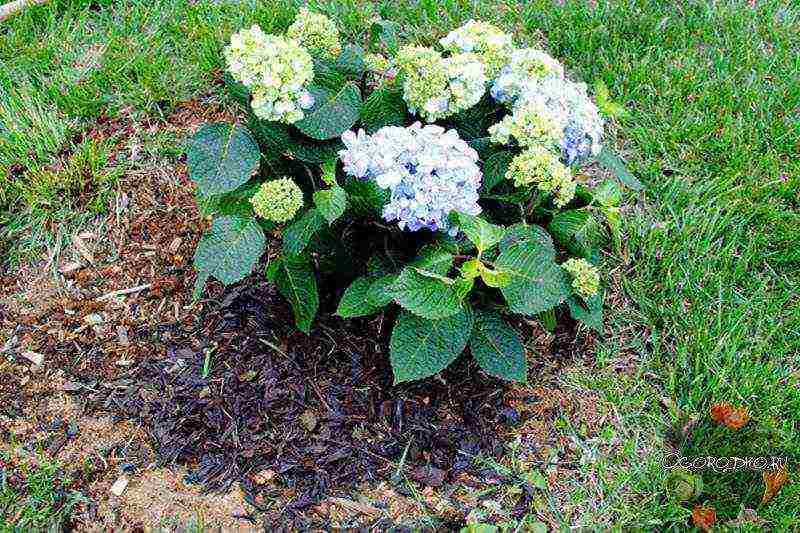 mulching hydrangea with wood chips - pictured
mulching hydrangea with wood chips - pictured
Panicle hydrangea, large-leaved and ground cover are predominantly pinkish, creamy colors that can be changed if desired. The color of the hydrangea is directly related to the acidity of the soil. If the soil is slightly alkaline, then the flowering will be pink and crimson; on acidic soils, the hydrangea blooms with blue flowers.
To obtain blue flowers in alkaline earth, the shrub is watered with solutions of iron salts. To get a more intense blue color, rusty metal cans should be buried under the hydrangea.
Pruning hydrangeas - continue to groom
Do I need to prune a hydrangea and how to do it? In order for the care to be correct, it must be remembered that pruning of hydrangea large-leaved, serrated, prickly, Sargent, liana-shaped, oak-leaved is carried out taking into account the fact that flowers appear on the shoots of the second year, which means that you need to cut off old branches and weak ones, to strong buds.
Pruning hydrangea paniculate and tree-like involves removing old and faded shoots, also weak. At the same time, experienced gardeners do not recommend removing a large number of shoots at the same time, it is better to stretch the procedure for a year or two so that the plant does not lose strength and does not die from excessive cutting operations. The main branches, as a rule, are not touched, only those that are bad and grow inside the bush are cut off.
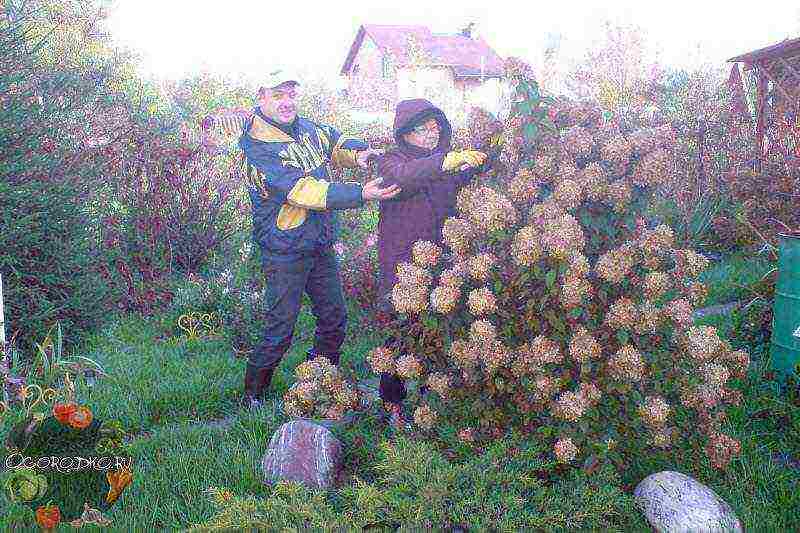 autumn pruning hydrangea - pictured
autumn pruning hydrangea - pictured
You can prune hydrangeas in spring and autumn, but it is preferable in the fall, since sap flow slows down, and a haircut will contribute to lush flowering in spring. In the spring months, improper pruning can slow down growth and delay flowering. In addition, in the spring, the processes begin to actively start at the shrub, juice is released during pruning, so be careful not to harm the plant. In spring, pruning is best done as early as possible, before the buds swell and constant heat is established.
Pruning hydrangeas for the winter is carried out as usual, with only one difference - it is better not to touch young shrubs and let them overwinter without surgery, otherwise you risk ruining the plant. Hydrangea, planting and caring for which is not at all difficult, will certainly delight with its lush flowering, if you suddenly decide to grow an unpretentious plant in your garden.
Gotense: related photos
 Do you want to decorate your garden with an unusual shrub? Try planting a hydrangea flower, planting and caring for which in the open field is simple, reproduction and growing of hydrangea is possible even for novice gardeners. You can find a fantastically beautiful flower by reading the description of the variety and considering its combination with other plants in landscape design. In the photo, the hydrangea looks like the queen of the garden.
Do you want to decorate your garden with an unusual shrub? Try planting a hydrangea flower, planting and caring for which in the open field is simple, reproduction and growing of hydrangea is possible even for novice gardeners. You can find a fantastically beautiful flower by reading the description of the variety and considering its combination with other plants in landscape design. In the photo, the hydrangea looks like the queen of the garden.
Varieties and varieties of hydrangea
Hydrangea is an undoubted favorite among flowers in summer cottages. A long flowering period, a variety of shapes and tones attract special attention to it from gardeners and designers; more and more often, various varieties of this perennial are used in landscape design.
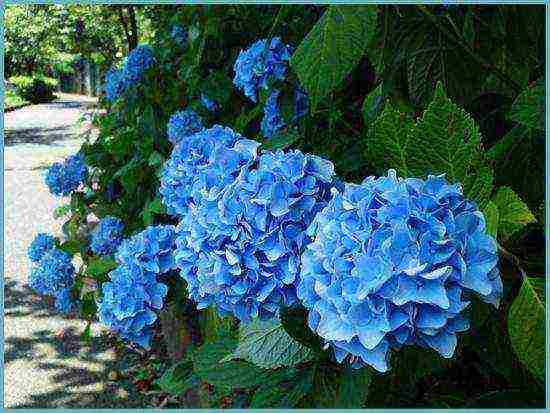
Blue hydrangea
Hydrangeas can be spherical, racemose, and white, lilac, red, two-colored in color. The most common in our latitudes is the tree hydrangea. Unpretentious, fairly easy to care for and grow, the plant is recommended for novice gardeners. Several varieties of shrubs have been bred by breeders:
- Bella Anna - a new variety of tree hydrangea, has rather large spherical inflorescences, the crown grows up to three meters in diameter, the color of the petals is from pale pink to purple-pink, blooms throughout the summer season and September;
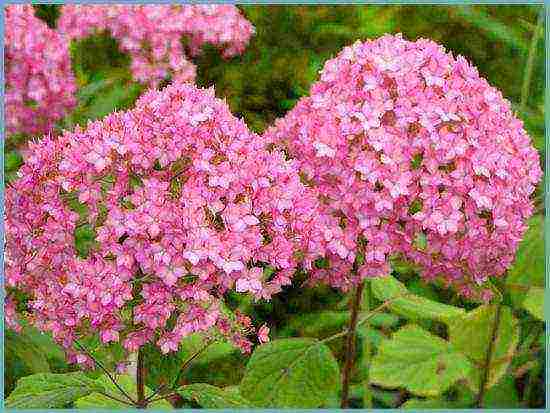
Bella Anna variety
- "Anabel" - a lush blooming, spreading shrub about 1.5 m high, inflorescences in the form of a ball of snow-white color, blooms in early July and retains its color throughout the summer season until September. After the end of flowering, the leaves of the plant remain bright green throughout the fall. Variety "Anabel" is adapted for wintering, does not require special shelter for the winter, frost-resistant;
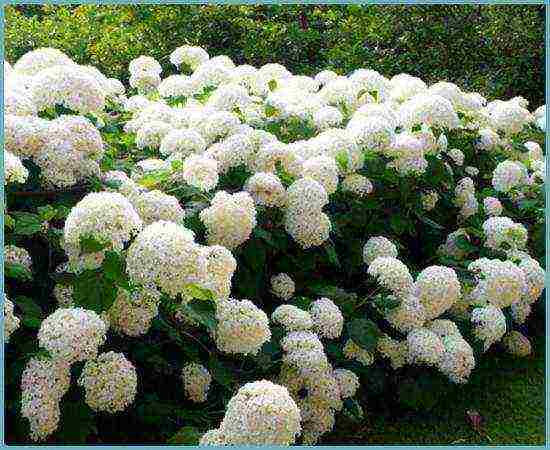
"Anabel"
- "Grandiflora" - differs in large crystal-white inflorescences, blooms for 4 months;
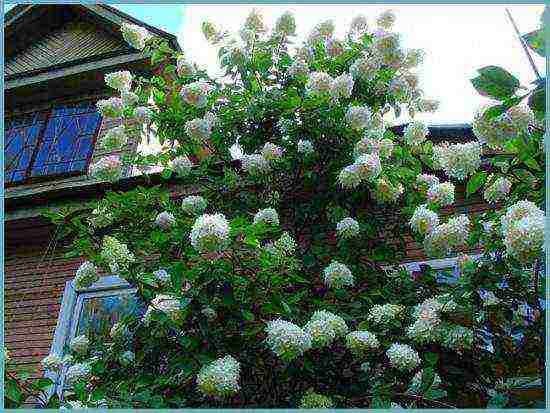
"Grandiflora"
- "Invincibel Spirit" - a new variety of hydrangea with pink petals;

"Invisibel Spirit"
- "Sterilis" - a variety with hemispherical, dense, heavy inflorescences, during the flowering period - from July to October - the petals radically change color: from pale green to crystal white.

"Sterilis"
Also, a fairly common perennial variety - Panicle hydrangea, planting and caring for which is quite simple. This flower is attractive with inflorescences of an unusual - paniculate - shape, frost-resistant, characterized by rapid recovery even in unfavorable climatic conditions. An interesting feature of this hydrangea variety is the particularly long flowering period, during which the inflorescence changes its color. Does not need mulching for the winter. The most common varieties of panicle hydrangea are:
- Vanilla Fraze - variety with pale white and pink petals;
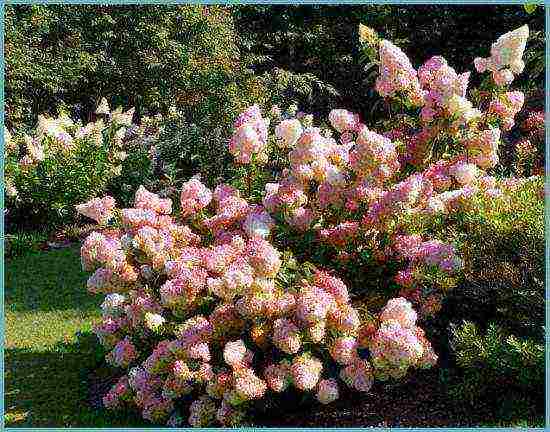
"Vanilla Fries"
- "Limelight" - the plant blooms in autumn, differs in large inflorescences of a pale lemon shade;
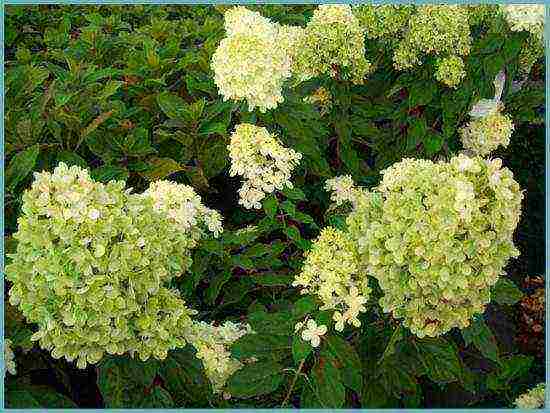
"Limelight"
- "Pinky Winky" - hydrangea with soft red petals.
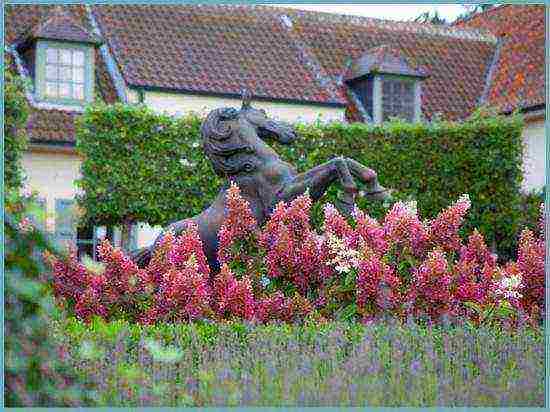
"Pinky Winky"
How to plant correctly
Growing hydrangeas in the open field is possible even for novice gardeners. If a hydrangea is chosen for a flower garden, planting and caring for it will never be a burden, they will become favorite activities. The correct location should be chosen for planting the shrub. Hydrangea does not tolerate long shading, the best place to plant it is on the sunny side. Hydrangea propagation is carried out by separate bushes or cuttings. It is recommended to plant a flower in spring (in May) or in autumn (in warm September).

Even a novice gardener can plant a hydrangea.
To plant a hydrangea with a bush in the open field, you need to dig a planting hole about 60 cm deep, about half a meter wide and long. The distance between the bushes is at least 1.5 meters. A flower, growing with proper care, will occupy a much larger area than when planted.The pits should be filled with a special mixture, including peat, sand, soil, humus (1: 1: 2: 2) and fertilizers (landscape design experts recommend combining 20 g of urea, potassium sulphide each, add about 60 g of superphosphate in granules and 10 kg of humus ).
Attention: do not add lime to the soil mixture for hydrangea - it is detrimental to this plant.
When planting, it should be borne in mind that the root collar of the plant should be at ground level. After planting the hydrangea in open ground, it must be watered abundantly.
Tip: For the first two flowering seasons, it is recommended to pick off the inflorescences. The root system of the plant will get stronger and grow, which will subsequently give the bush strength and splendor.
Suitable care
Hydrangea care consists in weeding and loosening the soil around it, organizing a timely and correct watering regime. In addition, to prevent rapid evaporation of moisture, it is recommended to mulch the bush in early summer with peat or sawdust.
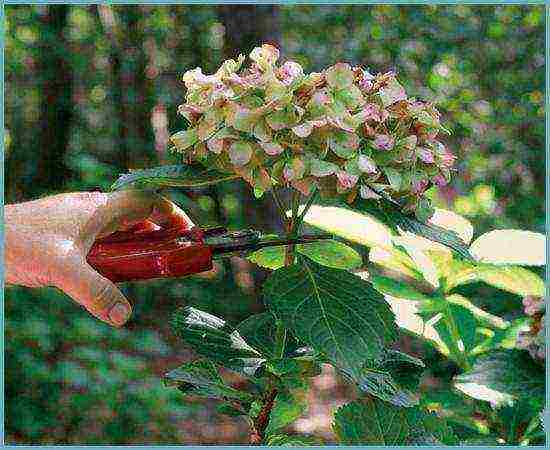
Fading flowers must be cut off so that they do not pull strength from the plant.
A perennial needs proper pruning. The plant should be pruned in the spring before the beginning of the growing season, removing old shoots and leaving young and strong ones, shortening them by 3-5 buds. Faded and dried bush inflorescences must be removed. Old perennial bushes must be cut almost at the root, leaving only low stumps, from which young shoots will develop.
Fertilizing and fertilizing hydrangeas
The hydrangea planted in prepared and fertilized soil for the first two years can not be fertilized or fed.
Then the procedure for feeding hydrangeas is as follows:
- in the spring it is necessary to apply a complex fertilizer containing micro- and macroelements (phosphorus, potassium, nitrogen) under each bush;
- the second time in a season, top dressing (potassium sulfate together with superphosphate) is applied during the period when buds appear on the bush;
- a couple of times it is advisable to feed the perennial with diluted chicken droppings or cow dung.
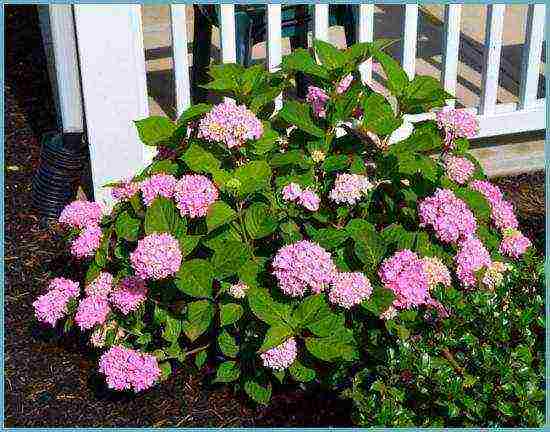
Hydrangea responds very well to feeding
Caution: Excessive fertilization of nitrogen can lead to greening of hydrangea petals and problems with the wintering of the plant.
It should also be borne in mind that hydrangea responds well to lactic acid, therefore it is important when growing it to periodically water the bush with soaked sour bread, milk whey, sour milk, kefir.
Propagation of hydrangea
Like other perennial shrubs, hydrangea can be propagated vegetatively (by cuttings, dividing the bush, layering) and seeds.
To grow shrubs from cuttings, it is necessary to cut the tops of young non-lignified shoots in mid-July and root them in specially prepared soil, consisting of coarse sand and peat. Experts recommend taking measures to increase soil moisture under the cuttings. For this, sphagnum moss is added to it. Cuttings are planted in such soil a little at an angle, at a small (up to 5 cm) distance and provide them with a temperature regime in the range of 16-20 ° C. 4-5 weeks are enough for rooting. After that, the hydrangea is planted in a permanent growing area and provided with proper care.
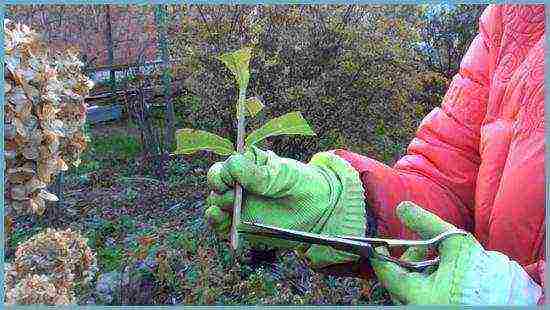
Propagation of hydrangea by cuttings
When the hydrangea propagates by dividing the bush, part of it is separated, while it is important that there are 2-3 buds on the young shoots, they are dug up and transplanted to a new place.
For the propagation of hydrangeas by layering, it is necessary to bend one of the young shoots of the growing bush to the ground and dig it into a previously dug hole (up to 15-20 cm deep). To prevent the shoot from straightening, it can be fixed with staples. Experienced gardeners recommend making an incision on the part of the shoot that will be in the ground to speed up the rooting process. It is necessary to regularly water the branch, it can also be mulched.After the formation of its own root system at the branch, it is separated from the mother bush and planted in a new place.

Propagation of hydrangea by layering
Diseases and pests
As a rule, hydrangea is quite resistant to all sorts of pests and diseases. However, it can also become infected with chlorosis, powdery mildew, spider mites, and green leaf aphids can appear on it.
Chlorosis is expressed in a sharp lightening of the leaves of the plant, the loss of their natural color. The reason for its development is the excessive content of lime or humus in the soil. To eliminate chlorosis, it is enough to water the plant with solutions of nitric acid potassium and copper sulfate in turn with an interval of three days.
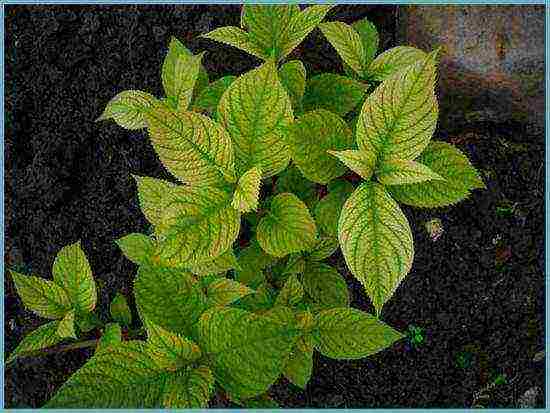
Hydrangea disease - chlorosis
The cause of hydrangea disease with downy mildew is excess air humidity. For treatment, it is recommended to treat the hardwood surface with a solution of copper sulfate with the addition of soap.
Garlic infusion will help drive aphids from the plant. It is necessary to prepare a garlic infusion (200 g of chopped garlic in a bucket of water, let it brew for 2 days), add laundry soap (40 g) and irrigate the perennial with this infusion every 5-7 days until the aphids are destroyed.
Hydrangea: combination with other plants
In a flower garden or garden, hydrangea is quite effective both by itself and in combination with other flowers. For example, panicle hydrangea looks great next to clumps of purple-leaved barberries, viburnum vesicle. The beauty of the tree-like hydrangea is emphasized by daylilies, sheared barberry, undersized juniper.
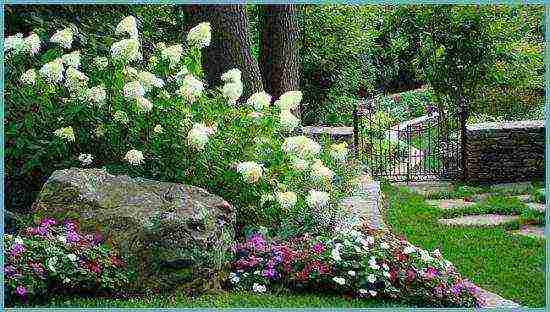
Hydrangea in the design of the flower bed
Hydrangea in landscape design
Hydrangea is a fantastically beautiful flower that inspires beautiful compositions in landscaping. Taking into account the climatic conditions, in our latitudes it is recommended to plant a tree-like, paniculate and petiolate hydrangea. Hydrangea looks magical in the photo in large compositions when it grows in the squares, surprising everyone with the size and beauty of its inflorescences. To emphasize the beauty of hydrangea, you can surround it with borders of spirits, cotoneaster, and other shrubs. The hydrangea should be planted in a flower garden in the background so that it does not obscure other plants.

Hydrangea in landscape design
It is not recommended to combine hydrangea with yellow, red, orange flowers. Plants with bluish flowers, needles or leaves can successfully shade a shrub - for example, clematis, cereals, hosts, low-growing junipers.
A classic landscape design is the combination of hydrangea with pink phlox with a round shape of inflorescences, thujas, microbiota. Also hydrangea is used in mixborders to create compositions along garden paths, can be grown as a hedge.
Hydrangea is the foundation of a beautiful garden. With proper care, it will delight you for years to come. Experiment with different varieties of this shrub, try to decorate your gazebo with a climbing hydrangea, plant a tree-like one along the paths, create a living fence using a paniculata.
Garden hydrangea care: video
Garden hydrangea: photo
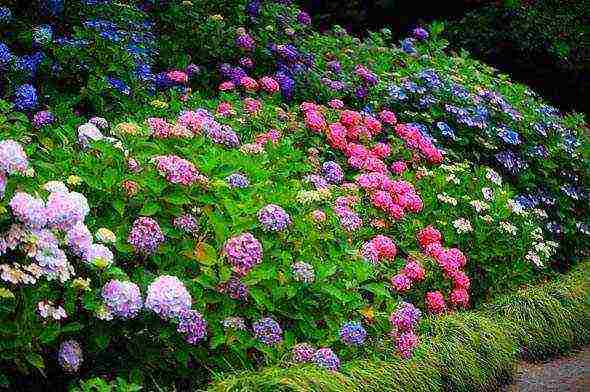
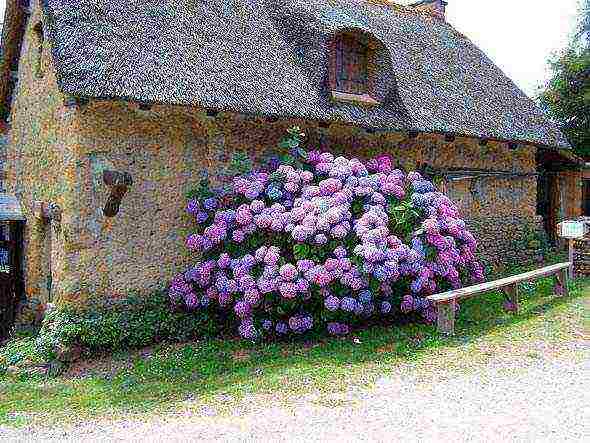
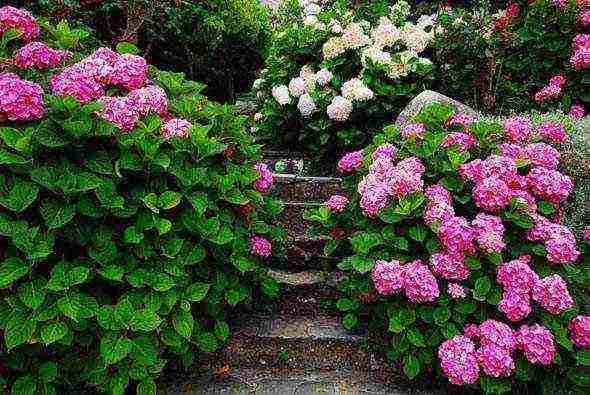
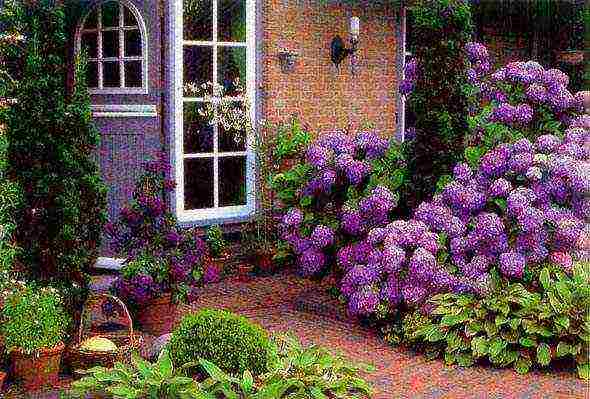


 Even in a very large garden area, it is impossible not to notice a flower bed decorated with large and multi-colored hydrangea caps. This wonderful beautiful plant is so mesmerizing to the eye that you simply cannot pass by it. Hydrangeas have more than 35 species, among which there are varieties that grow well and winter in the Urals and Siberia. But in whatever latitude of our country your garden is, before buying a beauty, you need to study all the features of planting, caring for and growing it.
Even in a very large garden area, it is impossible not to notice a flower bed decorated with large and multi-colored hydrangea caps. This wonderful beautiful plant is so mesmerizing to the eye that you simply cannot pass by it. Hydrangeas have more than 35 species, among which there are varieties that grow well and winter in the Urals and Siberia. But in whatever latitude of our country your garden is, before buying a beauty, you need to study all the features of planting, caring for and growing it.
Garden hydrangea: photos, types, varieties
Most hydrangea species are shrubs, but there are vines and small trees. All of them have beautiful large or small leaves, and flowers collected in paniculate or corymbose inflorescences.All inflorescences are located at the tops of the shoots and have sterile or fertile flowers. Most often, their color can be white, pink or blue.
Among them, only tree hydrangea and paniculate hydrangea are grown as perennial plants in the gardens of central Russia.
Hydrangea tree - photo
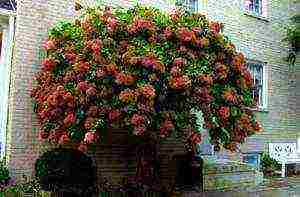 The shrub, which grows up to one and a half meters in height, has large oval leaves, the length of which reaches 20 cm. Slightly pubescent leaf plates are distinguished by a heart-shaped notch at the base and jagged edges along the edges. From above they are green, and from below they have a bluish tint. Large sterile and small fertile flowers are collected in corymbose inflorescences, which bloom in the first half of July.
The shrub, which grows up to one and a half meters in height, has large oval leaves, the length of which reaches 20 cm. Slightly pubescent leaf plates are distinguished by a heart-shaped notch at the base and jagged edges along the edges. From above they are green, and from below they have a bluish tint. Large sterile and small fertile flowers are collected in corymbose inflorescences, which bloom in the first half of July.
Most suitable for planting in the garden the following varieties of hydrangea tree-like:
- Variety "White House" is a bush with a height of one to one and a half meters. At the ends of its shoots, large thyroid inflorescences are formed, consisting of snow-white sterile and creamy white fertile flowers.
- InvincibelSpirit grows up to 0.9-1.2 m. Its large inflorescences consist of sterile flowers. At first, they have a bright pink color, and over time they fade to light pink.
- Variety "Incrediboll" is a bush that reaches a height of 1.2-1.5 m, and has large spherical white inflorescences.
- Heis Starburst is a short bush with slender shoots that can break under the weight of large inflorescences. The inflorescences, consisting of double flowers, reach 25 cm in diameter.
- The Annabelle variety blooms with white sterile flowers, which form large inflorescences with a diameter of up to 25 cm.
Hydrangea paniculata - varieties, photo
Panicle hydrangea differs from tree hydrangea in inflorescences, which consist of large sterile and small fertile flowers, and grow up to 20-25 cm in length... During flowering, they can change color. For the first time days, the petals of flowers are white, after a while they acquire a pink tint, and by the end of flowering they turn green. Large leaves of paniculate species are distinguished by an ovoid or elliptical shape. Below they are heavily pubescent, and slightly above.
Garden varieties bloom from June to July, and bloom for a long time. Among them are:
-
 Variety "Vanilla Freise" grows up to two meters and is distinguished by a conical inflorescence, on which flowers of a strawberry-pink color are densely located.
Variety "Vanilla Freise" grows up to two meters and is distinguished by a conical inflorescence, on which flowers of a strawberry-pink color are densely located. - The Phantom variety is a bush with a spreading crown, growing up to 2.5 m. Its pyramidal large inflorescences have a creamy white hue at the beginning of flowering, and turn pink by autumn.
- Variety "Pinky-Winky" is a bush up to 1.8 m high, on the shoots of which openwork conical purple-pink inflorescences are formed.
- The Limelight variety is distinguished by dense greenish inflorescences, which turn pink by the end of the season.
- The variety "Grandiflora" has been known among gardeners for a long time for its dense inflorescences, which consist of sterile flowers.
- The Vims Red variety is a beautifully shaped bush that reaches a height of 2 m. From the ground to the very top, it is covered with delicate inflorescences that bloom in June. At first they have a white color, then they become deep pink, and after a while - burgundy-red.
- The variety "White Lady" is distinguished by white inflorescences, which consist of a few flowers with jagged edges. Grows up to two meters.
- The Kiushu variety is a bush with delicate inflorescences and erect shoots up to 2.5 m high.
- The Great Star variety is a plant up to two meters in height. Its shoots are strewn with inflorescences, which consist of white flowers with petals in the shape of a "propeller".
- Earley Sensation is distinguished by its early flowering and dark purple shoots. On its openwork, wide-cone-shaped inflorescences, purple-pink flowers are formed.
- The variety "Diamond Rouge" is a bush up to 1.8 m high. Its dense, large inflorescences very quickly acquire a red hue.
- The Daruma variety is a low-growing shrub with reddish leaves and small openwork inflorescences. The dark pink flowers become reddish over time.
Features of growing garden hydrangea
Those who decide to grow a hydrangea on their garden plot need follow certain rules her planting, placement and care. It should be remembered that only treelike and panicle hydrangeas grow in Siberia.
Planting and leaving
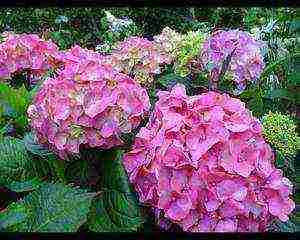 The plant loves well-lit areas with little shade. In sunny areas, hydrangeas grow well and bloom quickly, but from excessive heat they suffer from drying out of the soil and lose their turgor. Small inflorescences are formed in full shade.
The plant loves well-lit areas with little shade. In sunny areas, hydrangeas grow well and bloom quickly, but from excessive heat they suffer from drying out of the soil and lose their turgor. Small inflorescences are formed in full shade.
The soil for planting shrubs must have an acidic reaction. Alkaline soil plant will suffer from chlorosis and bloom poorly... Neutral soil for hydrangea is unacceptable.
Hydrangeas planted on nutritious loams will take root well and will grow. Therefore, it is recommended to add clay during planting at the bottom of the pit.
Hydrangea belongs to moisture-loving plants, however, it is not recommended to plant it in areas with a high groundwater level. In addition, the wintering of the shrub directly depends on the moisture intake of the plant roots. The less moisture they accumulate in the fall, the better the plant will overwinter. That is why in autumn the soil around the bushes must be partially covered from precipitation.
Planting garden hydrangeas is done in the spring in pits, approximate the dimensions of which should be 50x50x70 cm... The plant is planted after the last frost has passed.
Store-bought plants with a closed root system can be planted until the end of summer, preparing deeper and wider pits for them. After planting, the bushes are well watered, and the soil around them is 6 cm covered with sawdust or peat mulch.
The distance between plants should be between one and one and a half meters. If the group planting was conceived as a "hedge", then the bushes are planted more densely.
Watering and feeding
During the season in the open field, the bushes are watered once a week. In hot months, the frequency of watering increases up to 2 times a week.
Hydrangea care includes mandatory feeding, which produced twice a year:
- In May or June, during the budding period, the plant is fed with nitrogen fertilizers.
- In summer, the bushes need potassium, which is added according to the instructions.
It is better not to apply ash under hydrangea bushes, since it reduces the acidity of the soil.
Pruning hydrangea
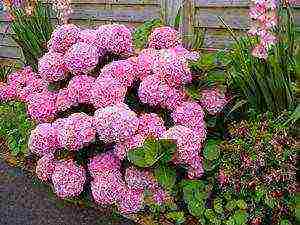 When caring for a hydrangea, you need to be especially careful about pruning a shrub. Pruning is done every spring. Some growers cut the bushes very short, as a result of which they are removed most flower buds... This cannot be done. It is recommended to approach each bush individually.
When caring for a hydrangea, you need to be especially careful about pruning a shrub. Pruning is done every spring. Some growers cut the bushes very short, as a result of which they are removed most flower buds... This cannot be done. It is recommended to approach each bush individually.
First of all, the frozen parts of the shoots are cut out from the plant. If after this there are enough powerful shoots, then last year's branches can be cut to the upper branch. With a small number of annual shoots, only inflorescences are removed from the faded branches.
Too old and thickening shoots are completely cut out. Annual shoots are not recommended to be cut out at all. It should be noted that inflorescences for bouquets can be cut during the entire period until autumn.
What to do to make the hydrangea change color?
Experienced flower growers know that by feeding bushes with pink inflorescences with certain fertilizers, as a result, you can get a plant, blooming with blue or blue flowers... To do this, starting in September, once every two weeks, the following is added to the soil:
- aluminum alum solution (2 pcs. for 1 liter of water);
- iron or aluminum sulfate (20-50 g).
If fertilizers are applied irregularly, then both blue and pink inflorescences will begin to form on the shrub.
Preparing hydrangeas for winter
Unfortunately, without shelter in the Urals and Siberia, hydrangea will not be able to overwinter.Therefore, caring for her in regions with cold winters includes preparing bushes for wintering.
Before sheltering the plant, it is necessary to feed it with phosphorus-potassium fertilizers and remove all the leaves from them, leaving only the upper ones. This will help speed up the process of lignification of the shoots.
Paniculate and tree hydrangea grown in the southern regions can be simply huddle high or cover with peat... For regions with unpredictable and cold winters, you can choose one of the proposed methods:
-
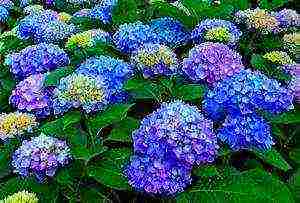 Cover the trunk circle with spruce branches. Bend the shoots away from the center, secure with staples and cover with spruce branches. Cover the center of the bush with peat. Lutrasil is laid on top, which is pressed with bricks or boards.
Cover the trunk circle with spruce branches. Bend the shoots away from the center, secure with staples and cover with spruce branches. Cover the center of the bush with peat. Lutrasil is laid on top, which is pressed with bricks or boards. - Young small bushes are tied with a rope and carefully, without haste, are attracted and tied to boards lying on the ground, into which nails are driven. From above, the plants are thrown with sawdust or spruce branches, and covered with spunbond, lutrasil or a sheet of iron.
- It will be difficult to pull powerful bushes to the ground, so a different method of shelter is used for them. The shoots are wrapped in lutrasil, fixed with tape or rope. A metal mesh is installed around the bush. Dry leaves are thrown inside the armament, and everything is covered with polyethylene or roofing felt from above. The frame should be 10-15 cm higher than the bushes.
When growing hydrangeas, you should know that every year it winter hardiness increases... Therefore, in some regions, over time, you can refuse to shelter bushes for the winter. But it is imperative to cover young plants.
Diseases and pests of garden hydrangea
The plant is resistant to diseases and pests, however, may be amazed:
-
 Aphids, which can be driven away by infusion of garlic. To do this, 200 g of chopped garlic is infused in a bucket of water for two days. You can add 40 g of laundry soap to the solution, and spray the plant once every 5-7 days.
Aphids, which can be driven away by infusion of garlic. To do this, 200 g of chopped garlic is infused in a bucket of water for two days. You can add 40 g of laundry soap to the solution, and spray the plant once every 5-7 days. - Powdery mildew infects hydrangeas with excess air humidity. When it appears, the plant is treated with a solution of copper sulfate with soap or special fungicidal agents.
- Sharply clarified hydrangea leaves indicate plant chlorosis. The leaves can lose their natural color due to the excessive content of humus or lime in the soil. Chlorosis is eliminated by alternately watering the plant every three days with copper sulfate and potassium nitrate.
The most beautiful hydrangea plant is excellent suitable for single and group plantings, goes well with low conifers and looks great against the background of stones. With proper planting and caring for it, you can admire the magnificent flowering and be proud of your flower garden all summer until autumn.
Garden hydrangea
At the sight of these flowers, there is a feeling of airiness and lightness, you want to pick a huge fluffy bouquet or plant whole rows
hydrangea
so that the multi-colored hats are on both sides of the garden
track
... The plant belongs to the Hortensian family. Most often these are small trees or shrubs, but there are even liana-shaped forms. Flowers are small, collected in large globular inflorescences, without aroma. Thanks to these beautiful inflorescences, the hydrangea cannot be overlooked.
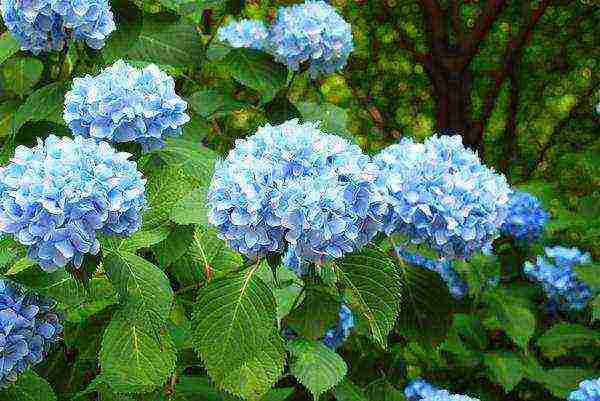
Hydrangeas It turns out that hydrangeas are not only beautiful, but also healing! Read about its use for medical purposes in the article "Healing hydrangea".
Planting hydrangeas
Hydrangeas are planted in early spring or fall. In cold climates, it is desirable spring planting of seedlingsso that they have time to root well and it is easier to endure the harsh conditions of the first (after transplanting) wintering. The place for planting must be chosen in advance: all hydrangeas love acidic, well-moistened soil. They can grow both in the sun and in partial shade.
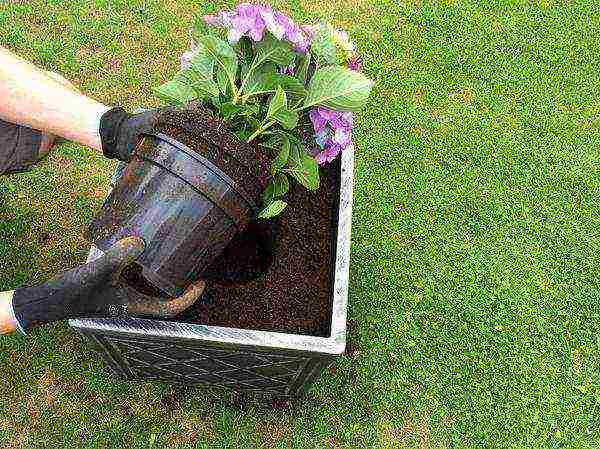
Planting hydrangeas Mineral and organic fertilizers, sand are introduced into a prepared hole about 30x30x30 cm in size, mixed well with sod soil. Then peat is poured. In a hydrangea seedling, the roots are slightly shortened.The root collar is not buried. The planted bush is well watered and mulched with humus or peat. When planting in spring, one-year shoots are slightly shortened by 3-4 buds.
Hydrangeas are usually planted singly or in groups on the lawn.
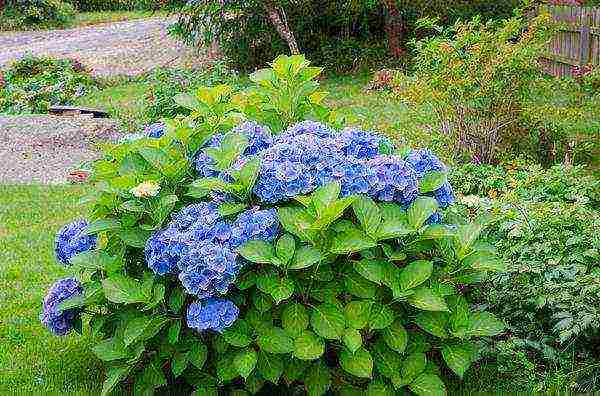
Hydrangea bush For group planting, the distance between plants should be at least 1 meter. You can read more about the planting process in the article Hydrangeas: A riot of colors in your garden.
Propagation of hydrangea
Cuttings
Cuttings are harvested in April-June: annual green shoots 10-12 cm long are taken from the crown, cut at right angles. Leaves are removed from the lower part of the cuttings, treated with a growth stimulant and planted in a fertile soil mixture - in a distribution ridge in a greenhouse. The first year after disembarkation (already in a permanent place) is covered in the winter, the flowers are cut off.
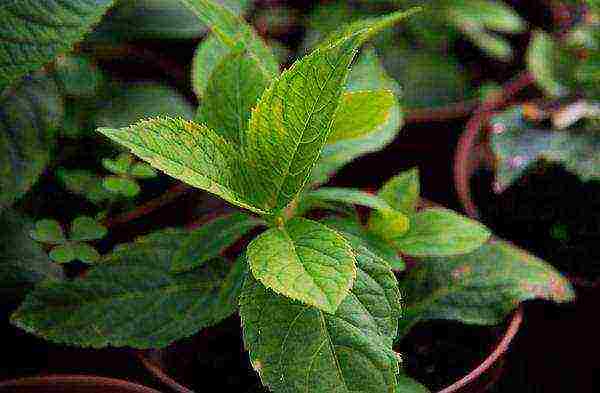
Young seedlings of hydrangeaWinter cuttings can only be carried out with large-leaved hydrangea. To do this, in October, you need to dig out the parent plant and plant it in a pot, put it in a room with a temperature of 0 ... + 2 ° C. In January, the temperature is raised to + 7 ° C ... + 10 ° C. In February, the shoots of last year have already ripened, and cuttings with 2 internodes are cut from them. The lower leaves are removed, the upper ones are cut off, leaving half of the leaf plate. The lower cut is treated with a root formation stimulant, and the cuttings are planted in pots with a nutritious soil mixture. Cover them with plastic bottles, glass jars.
By dividing the bush
Hydrangea can be propagated by dividing in spring and autumn. The plant is dug up and divided into several parts so that each division has a bud of renewal, after which it is planted in prepared places.
Layers
Shoots no older than 1 year are bent to the ground and buried in, leaving a top about 20 cm long on the surface.In the spring or autumn of next year, the rooted shoot is separated from the mother bush and transplanted.
Hydrangea is rarely propagated by seeds and grafting.
Hydrangea care
- Top dressing with mineral fertilizers (it is necessary to fertilize in moderation, since voluminous inflorescences can break or bend the branches of the bush).
- Organic fertilizers: slurry, humus.
- Watering. The acidity of water for irrigation is recommended not higher than 5.6 PH. Hydrangea is very hygrophilous and should not be overdried.
- Loosening of the soil: from 3 times per season to a depth of 5-10 cm.
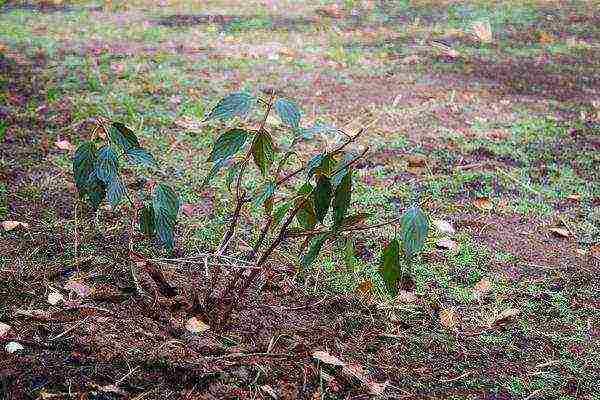
Hydrangea care
Pruning
- The bushes are cut in the spring when the buds are swollen.
- For successful wintering, young shoots are pruned to 4 buds.
- Old bushes are renewed by root pruning.
- With targeted formative pruning of cuttings for 4-5 years, you can get a beautiful little hydrangea tree.
- In the first year of flowering cuttings, flowers must be removed, this will help the plant gain strength and bloom profusely next year.
More information about the intricacies of pruning various types of hydrangea is described in the publications:
- Pruning hydrangea
- How to prune a panicle hydrangea
- The multifaceted panicle hydrangea (Hydrangea paniculata) and an alternative take on the formative "classic" pruning. Part 1
- The multifaceted panicle hydrangea (Hydrangea paniculata) and an alternative take on the formative "classic" pruning. Part 2
Change in color of hydrangea flowers
Large-leaved and new varieties of hydrangeas can change their color. To do this, use various dyes sold in fertilizer departments.
- If you want to get blue shades, then 2 times a week when watering, use crystals of aluminum or iron or aluminum sulfate (1 tablespoon for 5 liters of water).
- For a pink color, a solution of potassium permanganate is used.
- Peat can also affect the color change of hydrangeas. To do this, you need to water the plant with peat infusion, besides, it is also a good fertilizer.

Special additives will help to change the color of hydrangea inflorescences
Shelter for the winter
With the horizontal shelter of the hydrangea for the winter, you preserve the flower buds that are laid on the branches of the plant (in species that bloom on last year's shoots). Then the hydrangea will bloom early.
Problems
If trouble has happened to your hydrangea - the disease has overcome or it does not bloom - take a look at the Questions about hydrangea section: there are collected answers from both experts and amateur gardeners.
The main garden types of hydrangeas
Despite the variety of forms, this article discusses the species that take root and grow in our latitudes. Hydrangea suffers from intense heat, many species that love partial shade slow down their growth in the sun, their inflorescences become very shallow. But there are those that tolerate heat well.
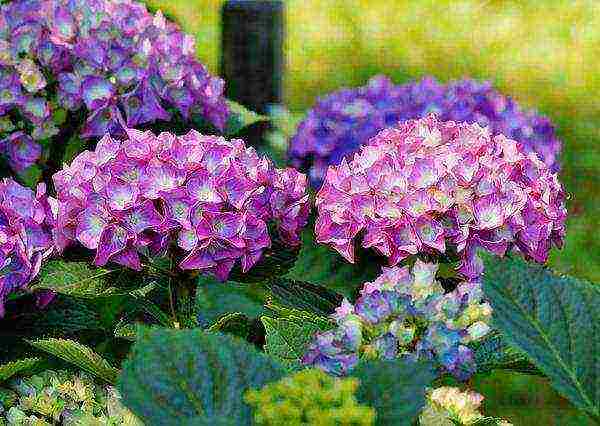
Blooming hydrangea
Large-leaved hydrangea (Hydrangea macrophylla)
Flowering occurs in July-August. Flowers of common forms are collected in corymbose inflorescences with a diameter of up to 20 cm, flowers of sterile forms are collected in lush spherical inflorescences with a diameter of up to 30 cm in white, pink, blue.

Large-leaved hydrangea (Hydrangea macrophylla) Shrub up to 2 m tall with large wide ovoid leaves. Heat-loving: requires shelter in frosty winters, tolerates frosts down to -10 ° C. The most common garden form in the world. The original form for potted hydrangeas. When potassium salts and aluminum sulfate are added to the ground, it allows you to get blue and blue inflorescences.
Hydrangea paniculata (Hydrangea paniculata)
Blooms from mid-summer to late autumn. Flowers are collected in dense panicles of pyramidal inflorescences up to 30 cm in length, color from light green to white, at the end of summer changes to dull purple. Shrub from 2 to 5 m in height or small tree up to 10 m.
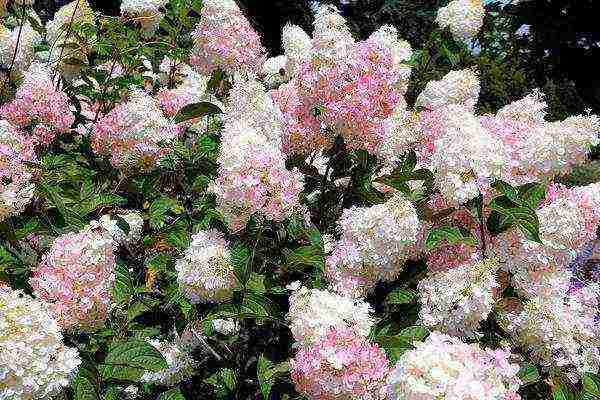
Panicle hydrangea (Hydrangea paniculata) Differs in durability, unpretentiousness (grows in swampy, gas-polluted places), frost resistance.
Hydrangea bretschneideri
The bush is compact, with a wide rounded decorative crown up to 3 m in height. Bloom from mid-July to August. The flowers are small, fruiting, collected in wide inflorescences in the form of umbrellas about 15 cm in diameter. The middle flowers in the inflorescence fall early, the marginal flowers bloom for a long time. The color at the beginning of flowering is bright white, towards the end - purple or reddish. Leaves are dark green, ovoid, 12 cm long. Hairy shoots, reddish, with bark exfoliation in the form of thin plates; completely lignified by winter.
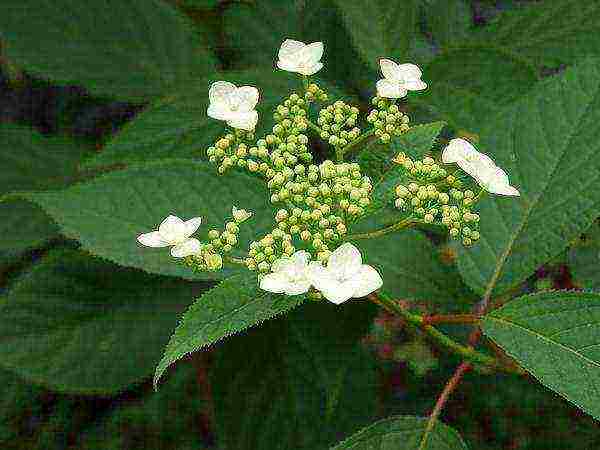
Hydrangea bretschneideri.
Stalked hydrangea (Hydrangea petiolaris)
The shrub vine is attached to the support with air suction cups, reaches up to 25 m in height, in the absence of support it spreads along the ground. Perfectly braids
arches
... The flowers are white-pink, collected in corymbose inflorescences up to 25 cm in diameter, quickly fall off.
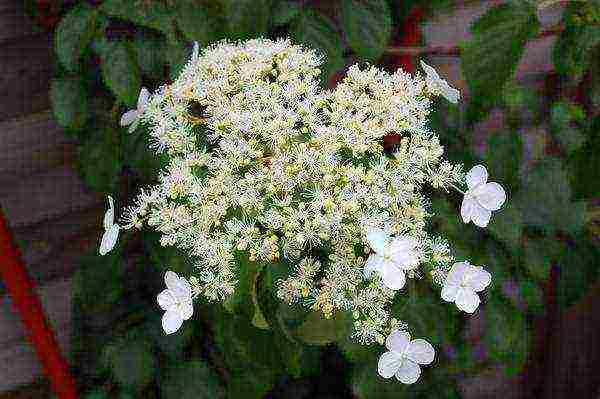
Stalked hydrangea (Hydrangea petiolaris) Abundant flowering is observed in open places, but also grows well in the shade.
Ash hydrangea, or gray (Hydrangea cinerea)
Shrub, reaches a height of 2 m. Used as a hedge. Blooms until late autumn.

Ash hydrangea, or gray (Hydrangea cinerea).
Hydrangea tree (Hydrangea arborescens)
A very beautiful shrub with many varieties. Bushes up to 3 m tall, with large oval leaves up to 20 cm in length. Flowers are collected in fluffy inflorescences. Often freezes in winter, but in spring it quickly recovers and blooms profusely. This form requires strong pruning (almost root) in April to keep the shrubs in good shape.

Hydrangea tree ‘Annabelle’ I have been growing for 10 years, blooms until late autumn, and in the flower garden is more noticeable than many of the more graceful and vibrant flowers.
What kind of hydrangeas grow in your garden? Tell us!

